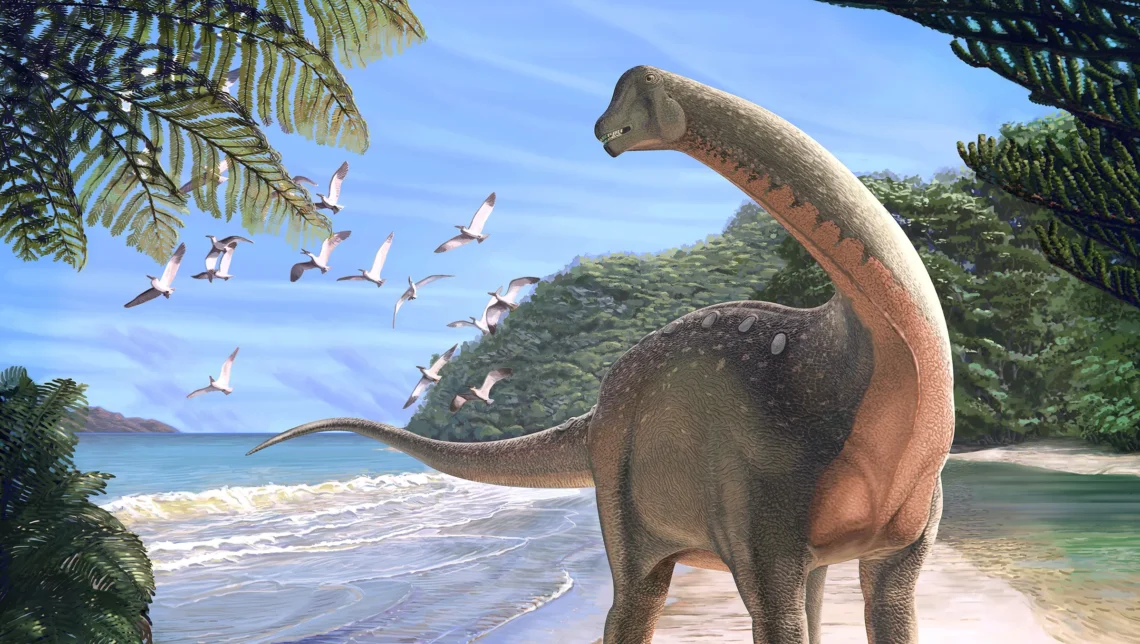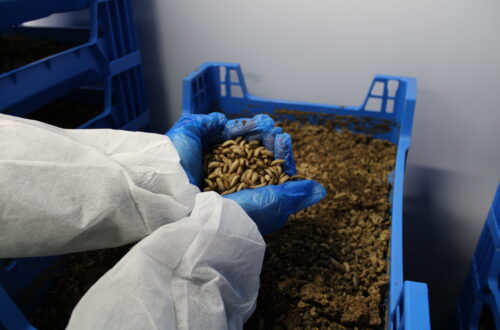In the quiet coastal cliffs of the Isle of Wight, a small island off England’s south coast, a remarkable discovery has brought together two seemingly unrelated worlds: paleontology and sailing. A newly identified dinosaur species, Istiorachis macarthurae, has been named in honor of Dame Ellen MacArthur, a record-breaking yachtswoman who sailed solo around the world in 2005. This “sail-backed” dinosaur, with its eye-catching spinal structure, has sparked excitement among scientists and the public alike. Let’s dive into the story of this fascinating find, exploring its scientific significance, the woman it honors, and why this discovery matters.
The Discovery of Istiorachis macarthurae
In 2025, paleontologists announced the discovery of a new dinosaur species, unearthed from 125-million-year-old fossils on the Isle of Wight. Initially mistaken for one of the two known iguanodontian species from the region, this medium-sized herbivore was identified as unique due to its distinctive sail-like structure along its back. The find, credited to PhD student and retired GP Jeremy Lockwood, has added a new chapter to the island’s rich paleontological history.
A Fossil Find Decades in the Making
The fossils, first excavated in the 1970s by fossil hunter Nick Chase, who sadly passed away in 2019, lay in museum collections for decades. It wasn’t until Lockwood’s meticulous analysis that their true significance came to light. His work revealed that the dinosaur’s tall neural spines were more exaggerated than those of its iguanodontian relatives, pointing to a new species.
Why the Isle of Wight?
The Isle of Wight is a paleontological treasure trove, often called the “Dinosaur Capital of the UK.” Its south-western coast, where Istiorachis macarthurae roamed 125 million years ago, was once a lush floodplain teeming with life. The island’s cliffs continue to yield fossils, making it a hotspot for discoveries that deepen our understanding of the Early Cretaceous period.
Why Name a Dinosaur After a Sailor?
The name Istiorachis macarthurae is a nod to both the dinosaur’s unique anatomy and Dame Ellen MacArthur’s legacy. “Istiorachis” translates to “sail spine” in Greek, reflecting the dinosaur’s distinctive feature, while “macarthurae” honors the sailor who made history with her record-breaking voyage. The connection between a prehistoric creature and a modern-day adventurer is as poetic as it is fitting.
The Sail Connection
Dame Ellen MacArthur, a native of Derbyshire but closely tied to the Isle of Wight, found the naming deeply touching. “The fact that the Istiorachis ‘sail’ could be likened to the sails I’ve spent so much of my life below was very moving,” she said in a statement. The sail-like structure of the dinosaur, likely used for display or species recognition, mirrors the sails that powered her historic journey.
Who Is Dame Ellen MacArthur?
Dame Ellen MacArthur is a household name in the UK, celebrated for her 2005 solo circumnavigation of the globe in just 71 days, a world record at the time. Beyond her sailing achievements, she’s the founder of the Ellen MacArthur Cancer Trust, a charity based in East Cowes that supports young people with cancer. Her connection to the Isle of Wight made her an apt choice for this honor.
The Science Behind the Sail
The defining feature of Istiorachis macarthurae is its exaggerated sail-like structure, formed by tall neural spines along its back and tail. But what purpose did this sail serve? Scientists have proposed several theories, with sexual selection being the leading hypothesis.
Sexual Selection and Display
Jeremy Lockwood, who published his findings in Papers in Palaeontology, suggests the sail was likely a product of sexual selection, much like a peacock’s tail. “The spines weren’t just tall—they were more exaggerated than usual in iguanodon-like dinosaurs,” he explained. This feature may have helped attract mates or signal dominance, much like vibrant plumage in modern birds.
Debunking the Thermoregulation Theory
Another theory, that the sail regulated body temperature, has been largely dismissed. Lockwood argues that a sail filled with blood vessels would have been vulnerable to attack, risking massive blood loss. Instead, the sail’s flamboyant design points to a role in visual communication, likely to impress potential mates or rivals.
Comparing Istiorachis to Other Sail-Backed Dinosaurs
| Dinosaur Species | Time Period | Sail Function Hypothesis | Location Found |
|---|---|---|---|
| Istiorachis macarthurae | Early Cretaceous | Sexual selection, species ID | Isle of Wight, UK |
| Spinosaurus | Late Cretaceous | Thermoregulation, display | North Africa |
| Ouranosaurus | Early Cretaceous | Display, possible thermoregulation | Niger |
This table highlights how Istiorachis fits into the broader context of sail-backed dinosaurs, with its sail likely serving a primarily social function.
The Significance of the Discovery
The identification of Istiorachis macarthurae isn’t just a cool new dinosaur name—it’s a window into the diversity of life during the Early Cretaceous. The Isle of Wight, 125 million years ago, was a hotspot for iguanodontian dinosaurs, and this find suggests greater species diversity than previously thought.
A Diverse Ecosystem
Lockwood’s discovery underscores the richness of the Isle of Wight’s prehistoric ecosystem. “The discovery of another iguanodontian shows this was a very diverse area in the Early Cretaceous,” he noted. The island’s floodplains likely supported a range of herbivores, each with unique adaptations.
The Role of Museum Collections
The fossils, housed at the Dinosaur Isle Museum in Sandown, highlight the importance of preserving specimens for future study. Professor Susannah Maidment of the Natural History Museum praised Lockwood’s work, noting that museum collections allow researchers to revisit old finds with new techniques, uncovering hidden gems like Istiorachis.
A Personal Connection to the Past
Imagine standing on the windswept cliffs of the Isle of Wight, where fossils erode from the rock like messages from a lost world. As a science enthusiast who’s wandered similar shores, I can attest to the thrill of imagining dinosaurs roaming where you stand. Naming Istiorachis macarthurae after Dame Ellen MacArthur feels like a bridge between past and present, connecting a modern adventurer to a creature that navigated its own ancient challenges.
Why Names Matter
Naming a dinosaur after a person isn’t just a tribute—it humanizes science. When I learned about Istiorachis, I couldn’t help but chuckle at the thought of a sailor’s legacy etched into a dinosaur’s name. It’s a reminder that science isn’t just about bones; it’s about stories that resonate across millennia.
The Emotional Impact on Dame Ellen
Dame Ellen’s reaction was heartfelt: “It’s not every day you’re asked if a dinosaur can reference your name. I was taken aback, but hugely privileged.” Her words capture the surreal honor of being linked to a creature that lived 125 million years ago, a connection that blends awe with humility.
Exploring the Isle of Wight’s Dinosaur Legacy
The Isle of Wight isn’t just a scenic getaway—it’s a paleontological goldmine. Its cliffs, constantly eroded by the sea, reveal fossils that have shaped our understanding of dinosaurs. Istiorachis macarthurae joins a roster of finds that make the island a must-visit for dinosaur enthusiasts.
Visiting Dinosaur Isle Museum
The Dinosaur Isle Museum in Sandown, where Istiorachis is now on display, offers a glimpse into this prehistoric world. Visitors can see the fossils up close and learn about the island’s role in paleontology. It’s a family-friendly spot that brings science to life.
How to Get Involved in Fossil Hunting
Fossil hunting on the Isle of Wight is accessible to amateurs and professionals alike. Guided tours, like those offered by local groups, teach you how to spot fossils safely. Always check tide times and stick to designated areas to protect the environment. For more details, visit Dinosaur Isle Museum.
Pros and Cons of Fossil Hunting
Pros:
- Hands-on connection to history
- Educational and fun for all ages
- Potential to contribute to science
Cons:
- Weather-dependent activity
- Requires patience and proper equipment
- Restricted areas to protect sites
People Also Ask (PAA)
Here are answers to common questions about Istiorachis macarthurae based on Google’s PAA data:
What is the new dinosaur named after Ellen MacArthur?
Istiorachis macarthurae is a newly discovered iguanodontian dinosaur with a sail-like structure on its back. Found on the Isle of Wight, it was named after Dame Ellen MacArthur due to her connection to the island and the sail-like feature resembling the sails of her record-breaking yacht.
Why was the dinosaur named after a sailor?
The dinosaur’s sail-like neural spines inspired the name Istiorachis (Greek for “sail spine”). Naming it after Dame Ellen MacArthur, a famous sailor from the Isle of Wight, connects the dinosaur’s unique feature to her sailing legacy.
Where was Istiorachis macarthurae discovered?
The fossils were found on the Isle of Wight, specifically along the south-western coast, a region known for its rich fossil deposits from the Early Cretaceous period.
What did Istiorachis macarthurae look like?
This medium-sized herbivore, about 2 meters tall and weighing around 1,000 kg, had a pronounced sail-like structure along its back and tail, likely used for display or species recognition.
FAQ Section
What does Istiorachis macarthurae mean?
The name combines “Istiorachis” (Greek for “sail spine”) and “macarthurae,” honoring Dame Ellen MacArthur. It reflects the dinosaur’s distinctive sail-like neural spines and her sailing legacy.
How old are the fossils of Istiorachis macarthurae?
The fossils date back 125 million years to the Early Cretaceous period, when the Isle of Wight was a floodplain inhabited by diverse dinosaurs.
Can I see Istiorachis macarthurae fossils?
Yes, the fossils are on display at the Dinosaur Isle Museum in Sandown, Isle of Wight. Check the museum’s website for visiting hours and exhibits.
Why is the Isle of Wight important for paleontology?
The island’s eroding cliffs expose fossils from the Cretaceous period, making it one of the UK’s top sites for dinosaur discoveries.
How can I start fossil hunting?
Join guided fossil walks on the Isle of Wight, bring sturdy shoes, and follow local guidelines to hunt safely. Visit Dinosaur Isle Museum for tour information.
The Bigger Picture: Why This Discovery Matters
The discovery of Istiorachis macarthurae is more than a new name in the dinosaur catalog—it’s a testament to the power of curiosity and persistence. Jeremy Lockwood, a retired doctor turned paleontologist, shows that science is accessible to anyone willing to look closely. His work, built on decades-old fossils, reminds us that the past is never truly finished speaking to us.
A Legacy of Exploration
Much like Dame Ellen MacArthur’s record-breaking voyage, this discovery is about pushing boundaries. Ellen sailed uncharted waters alone; Lockwood navigated uncharted fossils to uncover a new species. Both stories inspire us to explore, whether it’s the open sea or the depths of prehistory.
What’s Next for Dinosaur Discoveries?
The Isle of Wight’s cliffs will likely yield more surprises. With each fossil, we piece together the puzzle of Earth’s ancient ecosystems. Istiorachis macarthurae is a reminder that there’s still so much to learn, and maybe, just maybe, the next big find is waiting for someone like you to uncover it.
Call to Action: Explore the Past
If this story has sparked your curiosity, why not visit the Dinosaur Isle Museum or join a fossil walk? You don’t need to be a scientist to connect with the past—just a sense of wonder. For more on Istiorachis macarthurae, check out the Natural History Museum or read Lockwood’s study in Papers in Palaeontology.
Conclusion
Istiorachis macarthurae is more than a dinosaur—it’s a bridge between a prehistoric world and a modern hero. Its sail-backed silhouette, named for Dame Ellen MacArthur, captures the imagination, blending science with storytelling. As we marvel at this creature that roamed 125 million years ago, we’re reminded that exploration, whether on the high seas or in ancient rocks, is what drives discovery. So, next time you’re near a fossil-rich coast, take a moment to look down—you might just spot a piece of history waiting to be named.





